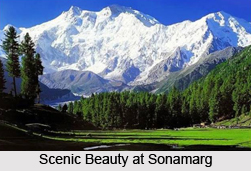 Sonamarg is a mesmerizing hill station in the Ganderbal district of Jammu and Kashmir. Sonamarg literally means "the meadow of gold" and with snow-capped mountains set against a spectacular blue sky, it is as close to heaven as it can get. The Sindh River flows through the valley. Ponies can be hired for the trip up to Thajiwas glacier, which is a major local attraction during summer.
Sonamarg is a mesmerizing hill station in the Ganderbal district of Jammu and Kashmir. Sonamarg literally means "the meadow of gold" and with snow-capped mountains set against a spectacular blue sky, it is as close to heaven as it can get. The Sindh River flows through the valley. Ponies can be hired for the trip up to Thajiwas glacier, which is a major local attraction during summer.
Location of Sonamarg
Sonamarg an alpine valley is situated at the bank of Nallah Sindh, 87 km north-east from Srinagar. Sonamarg is also the base of a major trek that passes along several mountain lakes like Vishansar, Kishansar, Gadsar, Satsar and Gangabal. It lies at an altitude of 2800 metres above sea level.
Demography of Sonamarg
Sonamarg had a population of 392, excluding tourists and those working in the tourism industry. Males constitute 51% and females constitute 49%. These are the permanent residents of Sonamarg, though seasonally.
History of Sonamarg
Sonamarg had historical significance and was a gateway on ancient Silk Road along with Gilgit connecting Kashmir with China and other Gulf countries. It still is a base camp for Ladakh on NH 1D, and is strategically important for Indian army who holds control over this part of Kashmir.
 Geography of Sonamarg
Geography of Sonamarg
Sonamarg gives rise to The Three Sisters (Kashmir). In its vicinity lies the great Himalayan glaciers of Kashmir Valley namely Kolhoi Glacier and Machoi Glacier with some peaks of above 5000 meters like Sirbal Peak, Kolhoi Peak, Amarnath Peak and Machoi Peak. The drive to Sonamarg is through yet another spectacular facet of country side in Kashmir, this time it is the Nallah Sindh, the largest tributary of the Jehlum River. It is upwards of sixty miles long valley and deep rock-girt gorge to open grassy meadow land and village-dotted slopes.
Lakes at Sonamarg
Vishansar lake is a little sparkling blue lake outside Sonamarg surrounded by lush green meadow, alpine flowers and white and silver mountains at a tantalizing distance. At an altitude of 3710 m, this lake secures a width of about 0.6 km and is also a habitat to a number of species of fishes.
Another lake which is located at a height of 3801 m above sea level, Krishnasar Lake, is one of the most mesmerizing lakes in Sonamarg. Surrounded by dense alpines, the place offers cool and pleasant atmosphere. The lake is popular for trout fishing while people also enjoy other water.
Tourism in Sonamarg
Sonamarg is also the base of a major trek that passes along several mountain lakes like Vishansar, Kishansar, Gadsar, Satsar and Gangabal. It is also the take off station for the drive to Ladakh across Zojila, a major pass in the Great Himalayan Range, through which the Srinagar-Leh Road passes. Sonamarg is also a base for undertaking the yatra to the holy Amarnath cave, during Sawan Purnima. The lakes of Gadsar, Krishnasar, Gangabal and Vishansar are also an interesting tourist destination here. Besides this, Baltal Valley is a must place to visit for nature lovers.
At Sonamarg the Jammu and Kashmir tourism department is organising river rafting tournaments yearly, which has recently seen the participation of teams abroad. A large number of Hindi movies have been pictured in the serene beauties of Sonamarg.
Sonamarg promises to quench one"s thirst for an adventure filled, adrenaline gushing vacation. The dense forests of Sonmarg comprise of sycamore and alpine flowers, silver birch, fir and pine. The place is frequently visited by nature lovers in search of tranquil peace and soothing natural beauty.
Trekking at Sonamarg
Located at 87 km from Srinagar, Sonamarg is renowned for trekking and hiking trails. The snow clad peaks in the Himalayas and the undulated hilly mountainous regions are perfectly suitable for all types of trekking expeditions. Sonamarg is the base camp for many trekking expeditions. The trekking routes offer all types of challenges, from mild to most hard. The pleasant climate with mild summer and cold winter make this place an ideal location for trekkers to explore the natural beauty and challenging treks. With plenty of trekking trails traced on the map of this town, Sonamarg is a delight for trekkers. Challenging mountain ranges, pristine lakes and plateaus make the region of Sonamarg suitable for all types of treks.
Best time to visit Sonamarg
Observing all the seasons of Sonamarg it could be easy to deduce that best time to visit the place is from April to October to those who like cool atmosphere but not frigid. The later could be experienced and enjoyed in the winters here.
Hotels and Accomodation at Sonamarg
Sonamarg has a number of Hotels and lodges of various types which are open only during summer months. Accommodation needs to be booked well in advance from Srinagar.
Visiting Information Sonamarg
Sonamarg is in Srinagar District on the Srinagar Leh Highway (approx.110 Kms from Srinagar). The nearest Airport is in Budgam District. This Airport is connected with major cities of India. The nearest Rail Head is at Jammu and from there National Highway NH1A connects the Kashmir valley with India.
Every sort of transport plies on this Highway. It takes around 10 to 12 hours to cross this mountainous road which crosses some beautiful spots and the famous Jawahar Tunnel linking Kashmir Valley with India. Bus service is available from Srinagar which leaves at fixed time from the Srinagar Bus stand. Taxis and other sort of transport can be hired from Srinagar at pre-fixed rates. Assistance is available at Tourist Reception Centre Srinagar.



















